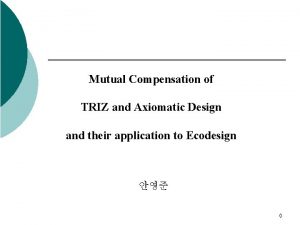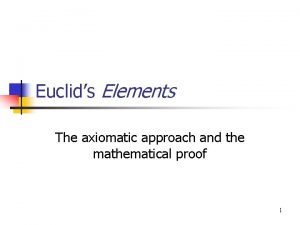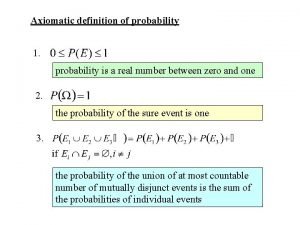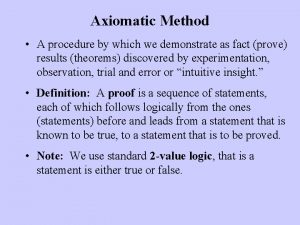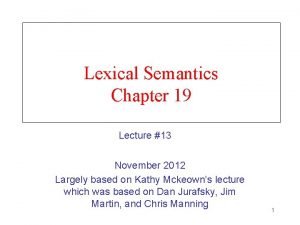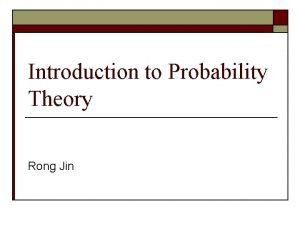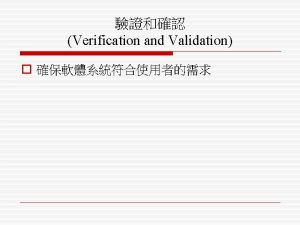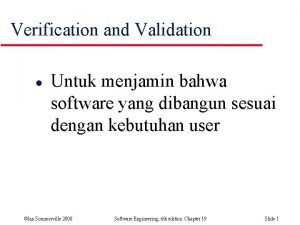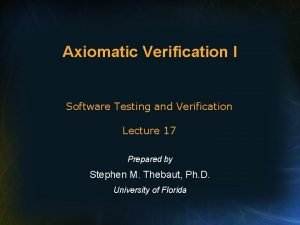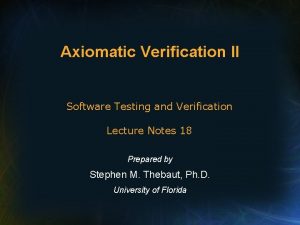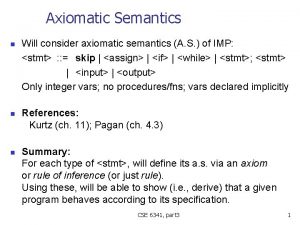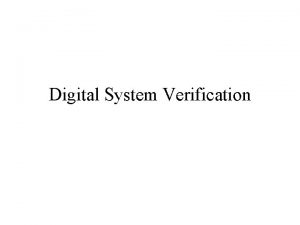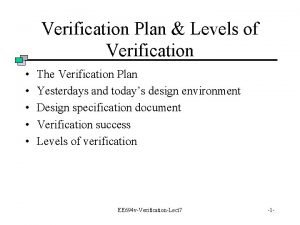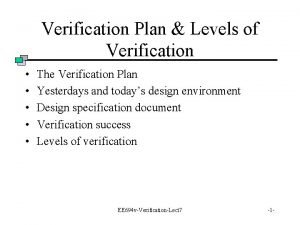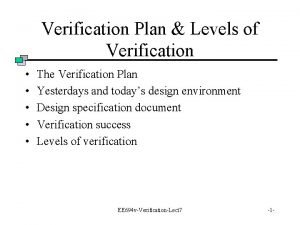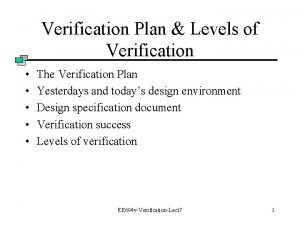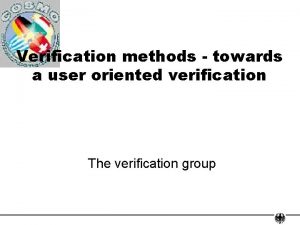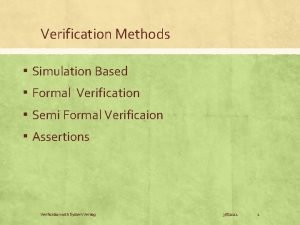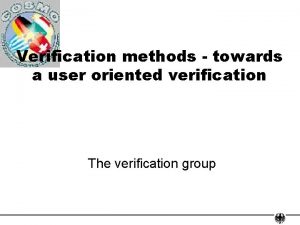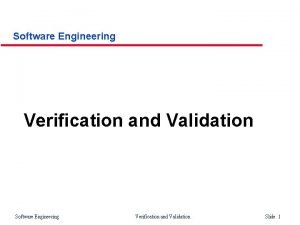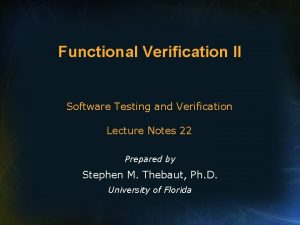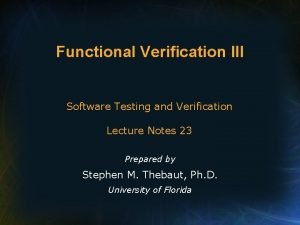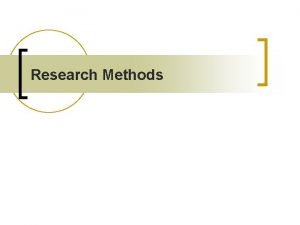Axiomatic Methods for Software Verification Hongseok Yang Things

























- Slides: 25

Axiomatic Methods for Software Verification Hongseok Yang

Things like even software verification, this has been the Holy Grail of computer science for many decades but now in some very key areas, for example, driver verification we’re building tools that can do actual proof about the software and how it works in order to guarantee the reliability. " Bill Gates, April 18, 2002. Keynote address at Win. Hec 2002

Verification Tools • Tools for software verification: – Compaq: ESC/Java – Microsoft: SLAM – KSU, NASA: Bandera • Axiomatic methods play a crucial role in those tools.

Axiomatic Methods • Hoare triple {P}C{Q} – P, Q: assertions such as (x==3)&&(y==z) – C: imperative programs – e. g. {x==4}y=x; {y%2==0} • Weakest precondition WP(C, Q) – WP(C, Q): the weakest P s. t. {P}C{Q} – WP(y=x; , y%2==0) = (x%2==0)

History • Naur 66, Floyd 67: – used assertions to specify/verify flowchart programs • Hoare 69: – developed the proof system for Hoare triples • Reynolds 00, Ishtiaq&O’Hearn 01 – extended Hoare’s proof system using separating connectives to handle pointers

Fibonacci Numbers • n’th Fibonacci number fib(n): – fib(0) = 0, fib(1) = 1 – fib(n+2) = fib(n+1) + fib(n)

Implementation in C if (n==0) { a=0; } else { i=1; p=0; a=1; while (i != n) { t=p; p=a; a=p+t; i=i+1; } } • Does this program calculate “fib(n)” and store the result in “a”?

Specification • Spec: {true}FIB{a==fib(n)}

Specification • Spec: {true}FIB{a==fib(n)} • FIB does not satisfy the spec: when n<0, fib(n) is not even defined!!

Specification • Spec: {true}FIB{a==fib(n)} • FIB does not satisfy the spec: when n<0, fib(n) is not even defined!! • New spec: {n>=0}FIB{a==fib(n)} • But, how can we be sure that the new spec holds?

Hoare Logic • Hoare logic consists of inference rules for proving valid Hoare triples. • So, we can use these rules to show that {n>=0}FIB{a==fib(n)} holds.

Rule for Conditional • So, {n>=0}FIB{a==fib(n)} holds if FIB satisfies: if (n==0) { {n>=0&&n==0}C 1{a==fib(n)} } else { {n>=0&&!(n==0)}C 2{a==fib(n)}}

Rule for Assignment • So, {n==0}a=0; {a==fib(n)} because n==0 implies 0==fib(n). • It suffices to show the correctness of C 2: if (n==0) { {n>=0&&n==0}a=0; {a==fib(n)} } else { {n>=0&&!(n==0)}C 2{a==fib(n)} }

Rule for Sequencing • So, it suffices to show: if (n==0) { {n>=0&&n==0}a=0; {a==fib(n)} } else { {n>=0&&!(n==0)} i=1; p=0; a=1; {a==fib(i)&&p==fib(i-1)&&i<=n} while (I!=n) { t=p; p=a; a=p+t; i=i+1; } {a==fib(n)} } We focus on this step

Rule for Loop • So, we have: {a==fib(i)&&p==fib(i-1)&&i<=n} while(i!=n) { {a==fib(i)&&p==fib(i-1)&&i<=n&&i!=n} t=p; p=a; a=p+t; i=i+1; {a==fib(i)&&p==fib(i-1)&&i<=n} } {a==fib(i)&&p==fib(i-1)&&i<=n&&!(i!=n)} We prove this in the next slide

Preservation of the Loop Invariant {a==fib(i)&&p==fib(i-1)&&i<=n&&i!=n} {(a+p)==fib(i+1)&&a==fib(i+1 -1)&&(i+1)<=n} t=p; {(a+t)==fib(i+1)&&a==fib(i+1 -1)&&(i+1)<=n} p=a; {(p+t)==fib(i+1)&&p==fib(i+1 -1)&&(i+1)<=n} a=p+t; {a==fib(i+1)&&p==fib(i+1 -1)&&(i+1)<=n} i=i+1; {a==fib(i)&&p==fib(i-1)&&i<=n}

Consequence • Since a==fib(i)&&!(i!=n) implies a==fib(n), we have: {a==fib(i)&&p==fib(i-1)&&i<=n} while(i!=n) { t=p; p=a; a=p+t; i=i+1; } {a==fib(i)&&p==fib(i-1)&&i<=n&&!(i!=n)} {a==fib(n)}

Simple Twist void PFIB(int *n, int *a) { int t, i, p; if (*n==0) { *a=0; } else { i=1; p=0; *a=1; while (i != *n) { t=p; p=*a; *a=p+t; i=i+1; } } } • Does the same reasoning prove {*n>=0}PFIB(n, a){*a==fib(*n)}?

Pointers cause a problem! • Not quite!! What if a=n? The problem is that the following rule is not sound. • Two Solutions: – Morris’s solution: modify subsitution using dynamic aliasing checks in the above rule – Reynolds’s solution: use separating conjunction “**’’ in assertions.

Semantics of Assertions • Semantic Domains – s 2 Stacks = Vars !fin Ints – h 2 Heaps = Nats !fin Ints – (s, h) 2 States = Stacks x Heaps • “(s, h)²P”: P holds for the state (s, h). – (s, h)²P&&Q iff (s, h)²P and (s, h)²Q – (s, h)²(xa. E) iff dom(h)={s(x)} and h(s(x))= «E¬

Separating Conjunction • #, * for heaps: – h 1#h 2 iff dom(h 1)dom(h 2) = ; – When h 1#h 2, h 1*h 2=h 1[h 2 • (s, h)²P**Q iff there exist h 1, h 2 such that – h 1*h 2=h; and – (s, h 1)²P and (s, h 2)²Q. • e. g. (nan 0)**true, (nan 0)**(aafib(n 0))

Rule for Pointer Swing • By this rule we can prove: {(nan 0)**(aafib(i))**(t==fib(i-1)&&p==fib(i)&&i+1<=n 0)} *a=p+t; {(nan 0)**(aap+t)**(t==fib(i-1)&&p==fib(i)&&i+1<=n 0)}

Correctness of PFIB(n, a) • Spec: {(nan 0)**(aa-)**(n 0>=0)} PFIB(n, a) {(n a n 0)**(a a fib(n 0))**true} • Loop Invariant: (n a n 0)**(a a fib(i))**(p==fib(i-1)&& i<=n 0)

Preservation of Loop Invariant {(n a n 0)**(aafib(i))**(p==fib(i-1)&& i<=n 0&&i!=n 0)} {(n a n 0)**(aafib(i))**(p==fib(i-1)&& i+1<=n 0)} t=p; {(n a n 0)**(aafib(i))**(t==fib(i-1)&& i+1<=n 0)} p=*a; {(n a n 0)**(aafib(i))**(t==fib(i-1)&&p==fib(i)&& i+1<=n 0)} *a=p+t; {(n a n 0)**(aap+t)**(t==fib(i-1)&&p==fib(i)&&i+1<=n 0)} {(n a n 0)**(aafib(i+1))**(p==fib(i)&&i+1<=n 0)} i=i+1; {(n a n 0)**(a a fib(i))**(p==fib(i-1)&&i<=n 0)}

Concluding Remarks • Why don’t you verify your C program using Hoare logic? • Well, even if you are lazy, you still might want to play with verification tools. Look at: http: //research. microsoft. com/SLAM
 Systems engineering verification methods
Systems engineering verification methods Axiomatic design example
Axiomatic design example Systematic oo
Systematic oo A list of undefined terms together with a list of axioms
A list of undefined terms together with a list of axioms Axiomatic design
Axiomatic design The axiomatic method
The axiomatic method Axiomatic probability formula
Axiomatic probability formula Axiomatic system of geometry
Axiomatic system of geometry Additive axiom
Additive axiom Axiomatic antonym
Axiomatic antonym Axiomatic probability definition
Axiomatic probability definition Verification and validation plan
Verification and validation plan Asset verification software
Asset verification software A software verification and validation method. section 19
A software verification and validation method. section 19 Software verification and validation plan
Software verification and validation plan Direct and indirect wax pattern
Direct and indirect wax pattern Ecosystem living and nonliving things
Ecosystem living and nonliving things Seven life processes pictures
Seven life processes pictures Fspos vägledning för kontinuitetshantering
Fspos vägledning för kontinuitetshantering Typiska drag för en novell
Typiska drag för en novell Nationell inriktning för artificiell intelligens
Nationell inriktning för artificiell intelligens Returpilarna
Returpilarna Varför kallas perioden 1918-1939 för mellankrigstiden
Varför kallas perioden 1918-1939 för mellankrigstiden En lathund för arbete med kontinuitetshantering
En lathund för arbete med kontinuitetshantering Underlag för särskild löneskatt på pensionskostnader
Underlag för särskild löneskatt på pensionskostnader Tidbok för yrkesförare
Tidbok för yrkesförare




